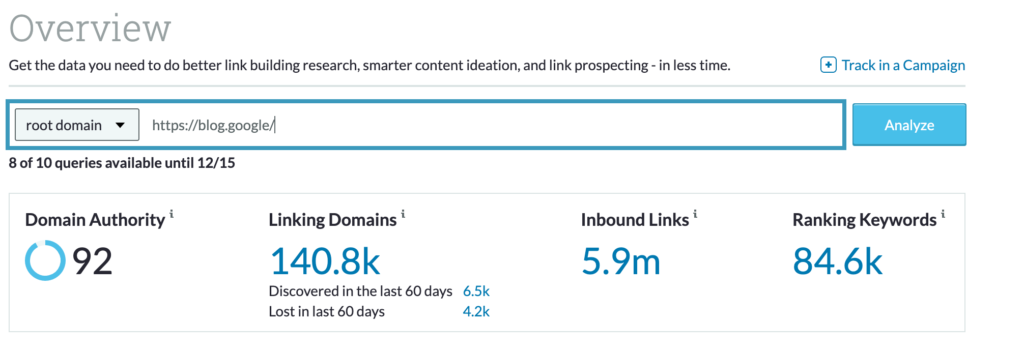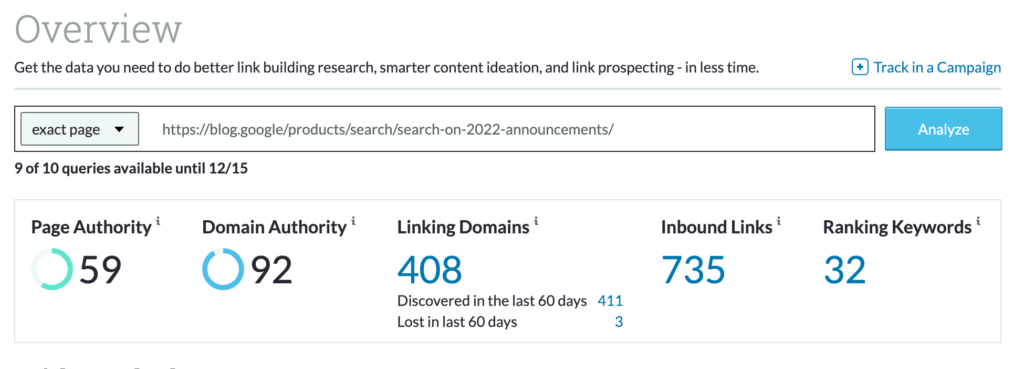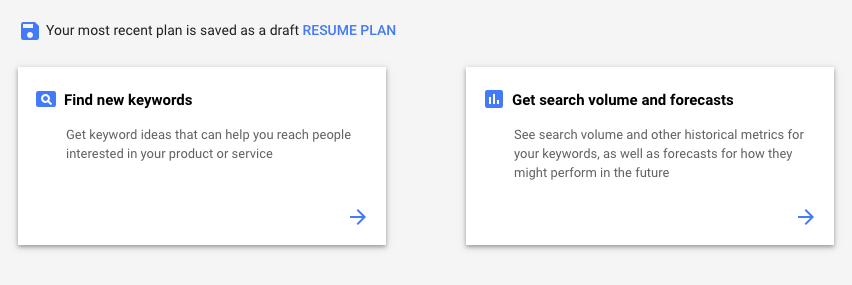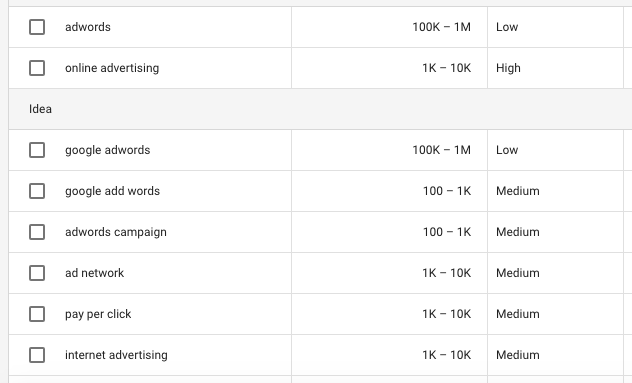New Blog Generation: A Step-By-Step Guide to SEO Keyword Research
Keyword research is a time-consuming and challenging process, but it is crucial in determining valuable content topics and themes to add to your site, and more specifically blog. In our experience, we typically spend multiple hours engaging in keyword research, when each new project begins. Conceptually, keyword research seems as simple as “here is a topic that should be addressed due to its significance for my business.” However, effective content marketing and blogging requires greater nuance in language use. In digital marketing, as in any relationship, how you communicate and your choice of language in that communication are essential to achieving your purpose.
Want to drive traffic to your website? Sometimes, companies and individuals think churning out short self-promotional posts on random topics will successfully drive traffic to a site. Some may also take too much time in planning and not enough time in the execution of blog development. However, when done correctly blogging increases the likelihood of engagement because you are adding value to your core audience. Although conceptualizing and crafting a blog takes more than a quick free write, brainstorming valuable content topics can be done in the course of a morning or afternoon. Sure, creating and promoting your content will take additional time, but as we all know, starting can be the hardest part of any endeavor. Once you have your topic list, you are well on your way!
5 Simple Steps to SEO (Search Engine Optimization) Keyword Research

If you can, allocate the half of your day when you are most energized and awake (or simply whenever you happen to have a chunk of time to dedicate to this work). Power up with your favorite coffee or green juice and get ready to do some brainstorming! Using these five steps to determine optimal keywords for your intended goals will not only result in learning more about your competition and current best practices in your professional arena but also a list of topics well-suited to the creation of new blogs that will enhance traffic to your website.
Have you already completed some of the designated steps? Go directly to a step that is newer to you using the menu below. Not sure of how to take any of these steps? Each section includes an explanation of the value of each action as well as “how to” guidance including visuals and examples.
Step 1: Identify Your Competitors & Publishers in Your Niche
Step 2: Check the Site (and Blog) Authority
Step 3: Identify Relevant (& Related) Topics
Step 4: Find Search Term Sweet Spots
Step 5: Match Keyword Research to Blog Topics
Step 1: Identify Your Competitors & Publishers in Your Niche
As a business owner, you are probably already aware of your competitors and publishers in your niche. However, including smart competitors and/or successful publishing sites are essential; in fact, publishers in your niche are often better sources of information than competitors. To clarify what is meant by “smart competitors,” popular, nation-wide businesses may have pervasive name recognition, but much of their development may have happened before current SEO standards, including the value and impact of blog use. Therefore, these companies may be the most recognized competition, but they may not be smart competitors, if they are not current in their use of best practices in digital marketing. Instead, look for the companies with a vibrant social media presence, a significant and ever-expanding content library, or a recently re-designed site.
This exploratory step helps you leverage the work of existing websites to find content topics you can create in order to drive traffic to your own website. To return to the previous example of established, big name competitors, their websites may be of little use in helping to identify currently engaging topics, if the sites in question have little content. Instead, put your effort into investigating competitors with strong marketing efforts and industry publications in your niche that are reputable, well read or often cited, and likely to have lots of traffic.
If you don’t already have an ongoing list of your competition, start by jotting down this list. Depending on your market, include competition in your area and well-known competitors in other locations. Comparable businesses in other locations may help you identify emerging trends even if those haven’t yet become notable in your area.
Step 2: Check the Authority of the Website and Blogs
Ultimately, your goal is to find the sites and blogs with the highest domain and page authority, so that you can glean information to help narrow your keyword selection. Websites benefit from blogging and content marketing, but keywords drive the traffic and thus power of your site, because more relevant traffic means more customers.
“IN CONTENT MARKETING, BUSINESSES PROVIDE INFORMATION GEARED TOWARDS THEIR TARGET AUDIENCE. FOR EXAMPLE, NEW BUSINESSES NEED TO BUILD A BRAND. CONTENT MARKETING HELPS WITH THIS MISSION BECAUSE WE CAN GEAR OUR MESSAGE TOWARDS INFLUENCERS IN OUR INDUSTRY. THINK ABOUT THE PURPOSE OF NETWORKING? TARGETING AND CONNECTING WITH SPECIFIC PEOPLE THAT HELP YOUR BUSINESS DEVELOP THEIR NAME. IN CONTENT MARKETING, THE SAME UNDERLYING PRINCIPLES APPLY. COMPANIES BUILD A DIGITAL FOLLOWING AND OFFER CONTENT THAT ESTABLISH THEIR MISSION. THEY ANSWER THAT AGE OLD QUESTION OF WHY THEY ARE IN BUSINESS!”
Each and every web site maintains a ranking. Typically, site authority corresponds to the size and strength of an organization. For example, Google.com, maintain a 94 domain authority. As expected, a large company with a powerful site should maintain a very high domain authority.
How to Check Website Authority
All websites have a ranking. Usually, site authority corresponds to the strength and size of an organization. For example, we all know the seemingly all-encompassing power and scope of Google.com; it’s likely that it is how you found this post! Accordingly, this website has a 94 domain authority.

In any professional niche, there are typically multiple power players, so you’ll need to narrow the search scope to find the best keyword options. To do so, identify the site strength and blog authority of the competitors on your list, as well as how many keywords your competitor ranks for. Head to Moz (free searches are limited) and enter the URL of your competitor into the Link Explorer tool. Your findings will look like those for Google modeled above, and your notes should document the domain authority (94) and the ranking keywords (20.3 million keywords for Google).
How to Check Page Authority
Just as you noted the domain authority of your competitors (as a benchmark) and keyword rankings, also check the same rankings for their blog. For Google, the domain authority drops slightly to 92, but the ranking keywords drops substantively to 84.6K.

As you conclude this part of your research, look at some recent and popular posts from your competitors, then run the post through the Link Explorer as well.

As part of any content marketing strategy, a high keyword ranking isn’t necessary for every post. Unique and interesting content, like announcements of new initiatives, help facilitate engagement. Many people are interested in the most searched topics, so Google’s brand and overall strategy are helped by any related posts. As you develop, refine, or refresh your content marketing strategy, remember that providing readers with varied post types and topics encourages more traffic and visitors to your site.
Step 3: Identify Relevant & Related Topics
Absolutely essential to SEO content strategy is keyword research. Consequently, a most effective approach in identifying and developing blog topics is keyword research.
“THE REASON SEO CONTENT IS SO EFFECTIVE AT BUILDING YOUR TRAFFIC IS BECAUSE IT’S STRATEGIC, AND TARGETS KEYWORD-DRIVEN CONTENT TOPICS THAT HAVE PROVEN SEARCH DEMAND, ARE RELEVANT TO YOUR PRODUCT OR YOUR SERVICES, AND THAT ALIGN WITH YOUR TARGET AUDIENCE’S INTERESTS. THE MOST IMPORTANT PART OF ANY SEO CONTENT STRATEGY IS TARGETING THE RIGHT CONTENT TOPICS, AND THOSE TOPICS SHOULD BE FUELED BY RELEVANT, INTENT-DRIVEN KEYWORDS WITH PROVEN SEARCH DEMAND.”
A list of relevant, traffic-driving keywords establishes a blog’s foundation in service to delivering on overall marketing goals. As you brainstorm your own ideas and conduct keyword and topic research on niche publication sites and those of your competition, keep the following keyword selection essentials in mind:
- Gauge Demand: Determine keywords with proven and significant search demand.
- Understand Intent: Review search queries to gain insights into the user’s search purpose, including gathering information, trying to solve a problem or looking for a product
- Measure Difficulty: Finding the difficulty of search terms in a search query helps you determine if and how you might outrank competitors
Using these metrics helps you prioritize potential blog topics and eventually track the performance of your own blog.
How to Identify Relevant Keywords
Google Keyword Planner is a free tool that helps you understand the fundamental metrics of search volume and other performance indicators.

Begin with your list of potential blog topics; then, brainstorm a handful of related questions. In continuing to use our Google example, “search” is key to their blog strategy. So, a quick consideration of that word might result in these topics:
- how to conduct a search?
- what do search results mean?
- what is a SERP?
- how to understand SERPs for beginners?
- how does Google make money?
- what is AdWords?
Key strands in this brainstorming relate to search and online advertising. So, the next step is to assess the search volume and interest around one of these topics. The screenshot below reflects the search volume and competition for the terms entered (adwords and online advertising), as well as recommended and related ideas. These potential ideas might provide some golden opportunities for you to capitalize on as your SEO keyword research continues.

Now that you have the metrics, consider your overall goals in relation to your topic selection. For example, to provide a primer on how online advertising works, using “internet advertising” would be an effective keyword, because the competition level of this term ranks as medium (vs. high for online advertising) while maintaining the same range of volume. Therefore, a blog driven by the keyword “internet advertising” has a better opportunity to rank on the search engine results page (SERP). Although the term differs slightly, it remains consistent with the focus of the marketing strategy.
Additionally, Google Keyword Planner has other benefits, like the identification of unattractive terms. Returning to the example, the terms “AdWords” and “Google AdWords” seem fitting but are actually challenging as topics; despite the search volume, the terms are too broad and vague as reflected in their low competition scoring.
Step 4: Find Search Terms Sweet Spots
Search term sweet spots are terms with significant search volume but limited competition (or difficulty), so terms with at least 1000 monthly searches and low to medium competition are ideal. More advanced keyword research refines term preference further through assessing the keyword difficulty.
“WHEN IT COMES TO KEYWORD DIFFICULTY, ONE PRIME AREA TO FOCUS ON ARE TERMS IN THE GOLDILOCKS ZONE [WHICH INCLUDES] KEYWORDS WITH NOT-TOO-MUCH COMPETITION, AND NOT-TOO-LITTLE SEARCH DEMAND. THIS IS A REAL SWEET SPOT BECAUSE THE CONDITIONS ARE JUST RIGHT. YOU CAN OFTEN CREATE CONTENT THAT HAS THE CHANCE DO WELL RIGHT out OF THE GATE FOR THOSE TARGET ‘SWEET SPOT’ KEYWORDS, PARTICULARLY IF THE SITE HAS DECENT DOMAIN AUTHORITY.”
When looking for sweet spots with the available tools, note that Google Keyword Planner offers a competition level that mainly focuses on the PPC (pay-per-click) and not necessarily the organic difficulty metrics that Ahrefs and Moz (and other tools listed at the end of the post) provide. Additionally, not many free tools provide unlimited paid or organic difficulty rankings. However, with some additional investment in keyword research, including organic difficulty rankings may direct you to sweet spots that can drive traffic to your blog.
Typically, the increase in search volume corresponds to the increasing difficulty that makes a term attractive. For example, a term with a search volume of 1,000 – 10,000 and a 40 difficulty is attractive because there is significant volume and limited difficulty. While it is worthwhile to create content based off of these metrics, a term with 100 – 1,000 search volume with a 40 difficulty is not, since there is not enough volume at that difficulty level to make it valuable. Conversely, if a term with that lower search volume had a 20 difficulty, then this term would be a useful long-tail keyword to address. In short, looking for sweet spots helps you determine if the keyword will make a blog worth developing in relation to the combination of keyword volume and difficulty.
How to Determine the Keyword Sweet Spot
Determining the sweet spot requires both art and science. Develop potential topics using your findings from researching competitors, as well as your own ideas. Again, using keyword research tools to understand and identify rankings, search volumes and related terms help you discern the topic’s potential. For example, if your competitor ranks well for Topic A, but the Keyword Planner tool highlights a related Topic B, put Topic B on your list. Developing an equally informational post on the related term will help increase traffic to your site, not that of your competitor.
Let’s revisit our Google example and ongoing keyword research modeling to see the process of finding a sweet spot. Here are the difficulty rankings for our potential topics:
- Internet advertising – 51
- Online advertising – 48
- Pay per click – 55
- Ad network – 40
Looking at this information, we discovered that online advertising yields a lower difficulty which makes it a better option than internet advertising (the topic we initially thought would be the preferable choice).
Notably, every niche contains different relative search volumes. In our model, search and online ads are a huge market, so the basic terms yield large volumes. So, if your company operates in a smaller niche market, it may not return terms with 1,000 or 10,000 searches each month, but you still analyze the data in the same way to find the sweet spots. Although the core terms may provide a relatively consistent number of results, they can still provide a benchmark for discovering long-tail terms.
Relative to our example, if Google ranked #1 for the term online advertising, it would be challenging to write your own post, as a smaller start-up search engine, that could outrank Google’s higher domain authority. However, targeting the term internet advertising is a better choice, because your lower DA business can create similar content to a competitor, using this opening. Now, you’ve found the sweet spot!
Step 5: Match Keyword Research to Blog Topics
The final step in simple SEO keyword research that will set you up for meaningful new blog development is the creation of a content calendar that includes actual blog topics. In thinking about your audience, you may know that people typically conduct searches for two reasons: 1) to find information and 2) to make transactions. Interestingly, about 80% of search queries are informational, such as when users are searching for facts or answers to a question. Accordingly, high ranking blogs are those that help people find the information that they are seeking. In this final phase of your keyword research, think about how you can match your terms and topics to the most fitting blog content types.
Carefully choosing from the range of different content types that best fit your thoughtfully compiled list of keywords can lead to the most effective blogs for searchers and all of their inquiries, including those that relate to your products or services. Here are the top 3 most noteworthy types of blogs that help drive traffic. As you scan the list that follows, jot down what type that you think will work best for each of your topics.
#1 “Best of” Lists
“Best of” lists provide the opening to drive users to your site and a unique vehicle that enables a single post to be ranked for a variety of terms. This type of blog frequently appears when researching a product, so there are many potential topics in any niche. Look at your list. Which “Best Of” topic relates to the focus of your business? As you recall, providing an overview and educational approach to content is important, since 80% of searches are informational. Consider the information below as you think about how you might move that term into a “best of” topic.
- Comprehensive List of Resources: Create a “one-stop” shopping list that includes at least 50 resources for information on the topic, as well as useful resources and additional tools that other similar resources may not provide.
- Unbiased & Neutral Position: Use a neutral voice and objective, unbiased perspective to gain the most traction; stick to the facts when it comes to all of the offerings, including your own product or service, if applicable.
- Highly Valuable Content: Since most searchers are exploring to learn, solve a problem or answer a question with your “Best Of” lists. This audience awareness may also build trust with potential customers.
Finally, although “Best Of” lists aim to drive search traffic, they also serve to boost social influence. To achieve this benefit, publish your list, and then contact the individuals or companies who are named or tag them on a social media platform. Hopefully, they will then return your acknowledgement via some form of public appreciation, which increases the visibility of your company and/or post.
Now that you’ve identified some topics that will work for this content type, it’s time to execute a “Best of” list post.
#2 Expert Roundup Posts
The Expert Roundup (or group interview) post is another variation on the “Best of” list. Similarly, this type of post will support social shares (and ideally reciprocal links), since you are thanking and acknowledging the experts in the post. In addition to the increased exposure, expert and group interview posts engage the audience by incorporating their most pressing questions and answers from the professionals.
In terms of ranking for product-related terms, Expert Roundup posts provide a perfect opportunity, because the typical product or sales page includes company specific information. Generally, there isn’t much SEO value to this information because the intention of the page is sales. Therefore, Expert Roundups may yield some really specific, valuable, and continuous SEO traffic, as further explained in our in-depth piece on Expert Roundup posts.
“[THE] SALESY PRODUCT PAGE ISN’T LIKELY TO RANK WELL, BUT A STRONG GROUP INTERVIEW QUESTION WITH A LOT OF GREAT RESPONSES COULD RANK WELL FOR [A PRODUCT] TERM. AS A RESULT, CONSIDER INCLUDING SOME CORE KEYWORDS IN A SOLID GROUP INTERVIEW QUESTION FORMULA. THE GOOD NEWS IS THAT MOST OF THE QUESTIONS WILL PROBABLY BE REALLY RELEVANT FOR MY PROSPECTS.”
When you start generating questions that you might include relative to a topic and this content format, carefully consider types of questions. Avoid questions that are easily answered with a yes or no or questions that are too broad or too limited in terms of answer potential, which may relate to a single repeated answer or minimal information.
Instead, here are some helpful question frames that you might use:
- Biggest Mistake: “What is the Biggest Mistake {Job Title or Persona or Company Type} Makes with {Concept or Process}?”
- Best Tips/Hacks: “What is Your {Best / Most Actionable} {Tips / Hacks} for {Concept or Process}?”
- Favorite Tools: “What’s your {Favorite / Most Used} tool for {Concept or Process}?”
- Success Stories: “Can You Share One Great {Example / Story} of a {Concept or Process} Success?”
- General Creativity: “What’s the Most Creative {Concept or Process} {Tip / Example} You’ve Ever {Seen / Heard}?”
- Top Traits: “What are the Top Traits of Highly Successful {Business Type}?”
#3 Glossary Posts
In conducting your keyword research, you may have accumulated a variety of technical terms. These terms are unlikely to work well with “Best of” lists or the Expert Roundup approach, but they will make helpful and purposeful glossary style posts.
A glossary style post provides informative resources, and it may also generate leads because a collection of these resources accumulates into a virtual library of educational content. Glossary posts provide the following benefits to your business and your users:
- Educate and inform your audience.
- Position your company as an industry knowledge base.
- Build awareness for your brand, your product or your services.
- Drive relevant and qualified traffic to your site.
- Encourage early-stage prospects into your sales funnel.
Our glossary explainer provides further guidance on developing these types of posts:
“GLOSSARY CONTENT SHOULD BE SIMPLY WRITTEN AND IN BASIC TERMS. THE GOAL IS THAT PRETTY MUCH ANYONE READING THESE PAGES WILL COME AWAY WITH A VERY CLEAR, GENERAL UNDERSTANDING OF THE TOPIC. RESIST THE URGE TO GET TOO TECHNICAL OR ACADEMIC WITH THE SUBJECT MATTER BECAUSE YOU RISK CONFUSING AND LOSING YOUR AUDIENCE.”
Glossary posts diversify the overall content portfolio, are fairly straightforward to create, and tend not to change over time, due to their technical nature. In many niches, these posts drive significant traffic to your site, because of their tremendous long-tail keyword content.
For more on executing a glossary post, this Glossary Explainer provides tips for successful development.
Keyword Research Tools
In this guide, we’ve already referred to many of these keyword research tools, their accessibility, and their available support in your research process. The additional resources on the list of tools below will also help you brainstorm ideas, which will provide the foundation for blogs that will increase traffic to your site.
- Google Keyword Planner
- Google Search Console
- Moz Keyword Explorer (paid)
- Moz Keyword Difficulty Tool (paid)
- Google Trends
- Google Auto Suggest
- Ahrefs Keywords Explorer (paid)
- SEMrush Keyword Research (see our in-depth review of SEMrush)
- KeywordTool.io
- GrepWords (paid)
- Ubersuggest
- Term Explorer (paid)
- KWfinder
- Serpstat
- Bing Webmaster





